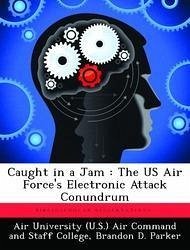
Caught in a Jam: The US Air Force's Electronic Attack Conundrum
Versandkostenfrei!
Versandfertig in über 4 Wochen
53,99 €
inkl. MwSt.

PAYBACK Punkte
27 °P sammeln!
Caught in a Jam: the US Air Force's Electronic Attack Conundrum Stealth or low-observable aircraft are not a substitute for air defense suppression. As Air Force leaders strive to recapitalize the air fleet with fifth generation capability, they are failing to address a core component of modern air combat--electronic attack (EA). Electronic attack is the shield that protects all generations of air assets from the bite of integrated air defense systems. No form of warfare, including stealth air warfare, is sufficient on its own. All are able to be threatened in ways that make them vulnerable to...
Caught in a Jam: the US Air Force's Electronic Attack Conundrum Stealth or low-observable aircraft are not a substitute for air defense suppression. As Air Force leaders strive to recapitalize the air fleet with fifth generation capability, they are failing to address a core component of modern air combat--electronic attack (EA). Electronic attack is the shield that protects all generations of air assets from the bite of integrated air defense systems. No form of warfare, including stealth air warfare, is sufficient on its own. All are able to be threatened in ways that make them vulnerable to attack. This lesson was evident in Kosovo almost a decade ago when Serbians armed with early generation surface-to-air missiles where able to track, target, and shoot down an F-117 stealth fighter. This lesson seems lost, unfortunately, by today's air leaders seeking to acquire more advanced, high-priced, fighters to re-posture our nation's air inventory. While these procurements are certainly warranted, they do not guarantee a significantly higher probability of success without adequate support jamming assets in the anti-access environment of an advanced, sophisticated air defense network. Our adversaries have the benefit of observing two decades of stealth employment and are not complacent. The Air Force must take bold steps now to cement its stake in securing the shield that has protected coalition air assets since the Vietnam War. If the Air Force continues to ignore the EA gap staring them in the face, the fundamental operational concept of air employment will be significantly altered and the entire force structure will be at greater risk. The US Navy has provided electronic attack for the joint force since the mid-1990's when the Air Force decided to retire its EF-111 and RF-4 airframes in the wake of the successes of the Persian Gulf War. Stealth technology was seen as a panacea for defeating air defense systems. The Navy, lacking organic stealth capability, decided t














